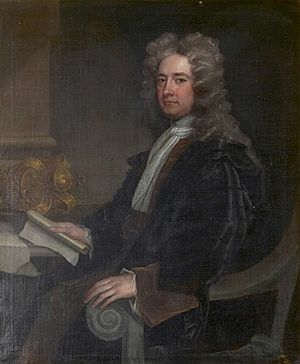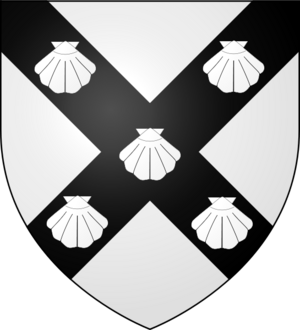William Conolly facts for kids
Quick facts for kids
William Conolly
|
|
|---|---|

Portrait of William Conolly
|
|
| Personal details | |
| Born | 9 April 1662 Ballyshannon, County Donegal |
| Died | 30 October 1729 Castletown House, Celbridge, County Kildare |
| Nationality | Irish |
| Spouse | Katherine Conyngham |
| Relations | William James Conolly (nephew), Thomas Conolly (great nephew) |
William Conolly (born 9 April 1662 – died 30 October 1729) was a very important Irish politician. People often called him Speaker Conolly. He was a lawyer and a big landowner. He became a powerful figure in Irish politics. He served as the Speaker of the Irish House of Commons from 1715 until he died.
Contents
Who Was William Conolly?
William Conolly was born in Ballyshannon, County Donegal. His father, Patrick Conolly, was an inn-keeper. Patrick came from County Monaghan. He decided to become part of the Anglican Church. William was one of his sons.
William's father saved enough money for him. This allowed William to study law in Dublin. In 1685, when he was 23, William became a qualified attorney.
William Conolly's Family Life
William worked as a lawyer in Dublin. In 1694, he married Katherine Conyngham. Her father was General Sir Albert Conyngham. Katherine's family, the Conynghams, were from Ulster Scots background. They were originally from Mountcharles in County Donegal. Later, her family moved to Slane Castle in County Meath.
William and Katherine did not have any children. After Katherine died in 1752, William's estates went to his nephew, William James Conolly.
How William Conolly Became Wealthy
William Conolly made a lot of money from buying land. This happened after King James II's supporters lost their lands. This was after the "Williamite War in Ireland" (1688–1691). About 600,000 Irish acres were taken by the Crown. This land was sold to help pay for the war.
William Conolly was the biggest buyer of these lands. He bought 3,300 acres in County Meath. This made him one of the wealthiest men in Ireland.
Building Grand Houses and Important Buildings
William Conolly built Castletown House in Celbridge, County Kildare. He started building it in 1722. It was the first house in Ireland built in the Palladian style with wings. He insisted that only Irish materials be used.
His home in Dublin was on Capel Street. This was a very fashionable area back then. He also helped build the Old Custom House. He also commissioned the Irish Houses of Parliament. This was the first building in the world designed for a two-part parliament.
William Conolly's Political Role
Conolly was a key figure in the Irish House of Commons. He was one of the "Undertakers." These were people who managed government business. He was part of the moderate Whigs.
He was a Member of Parliament for Donegal Borough from 1692 to 1703. Then he represented County Londonderry until his death in 1729. He was also elected for other areas but chose not to sit.
From 1715 until his death in 1729, he was the Speaker of the Irish House of Commons. He was also a Commissioner of the Revenue. His family name was spelled "Conolly," which is different from the more common "Connolly."
After William Conolly's Death
When William Conolly died, he was thought to be the richest man in Ireland. His income was estimated at £17,000 per year. His wife, Katherine, continued to live in luxury at Castletown. She lived there until she died in 1752.
Katherine built some interesting structures. These include the Wonderful Barn and the Conolly Folly. After Katherine died, the estates went to William's nephew, William James Conolly. Later, they went to his great-nephew, Tom Conolly.
Today, there are pubs named after him. "The Speaker's Bar" is in Celbridge. "The Speaker Conolly" is in Firhouse, Dublin.
William Conolly's Wealth and Land Holdings
William Conolly was known as the wealthiest person in Ireland when he died. He bought many large estates. In 1718, he paid £32,000 for 30,586 acres in Ballyshannon, County Donegal. In 1723, he bought 10,360 acres in Rathfarnham, County Dublin, for £62,000. He also bought 809 acres in Leixlip, County Kildare, for £12,000 in 1728.
His property in Celbridge was 2,300 acres. He bought it in 1709. By the time he died, he owned 148,487 acres. This land brought him a yearly income of £14,926.
The Conolly family also had a home called "Cliff House." It was on the River Erne between Belleek, County Fermanagh, and Ballyshannon, County Donegal. This house was later taken down. It was removed to make way for the Erne Hydroelectric scheme. This project built power stations like Cliff and Cathleen's Fall. The Cliff hydroelectric power station was built on the site of "Cliff House" in 1950.


